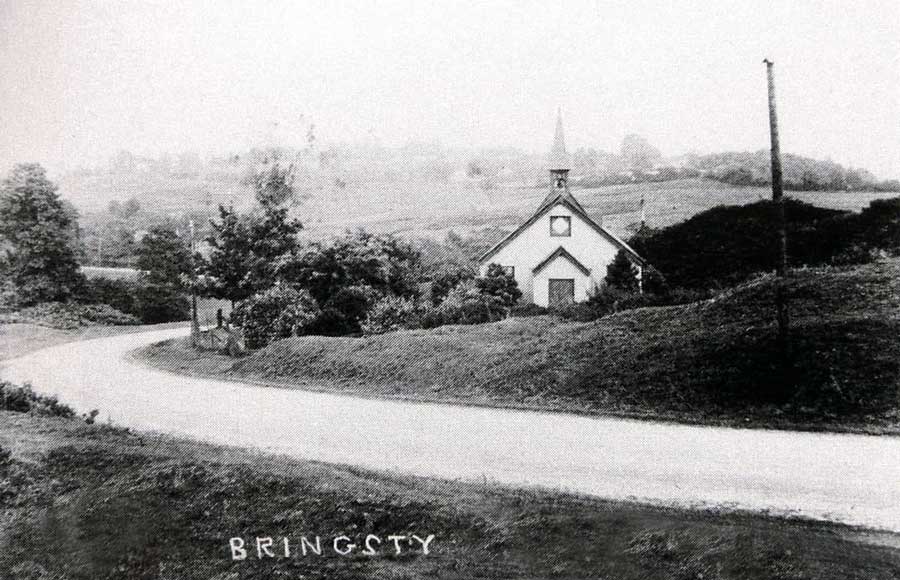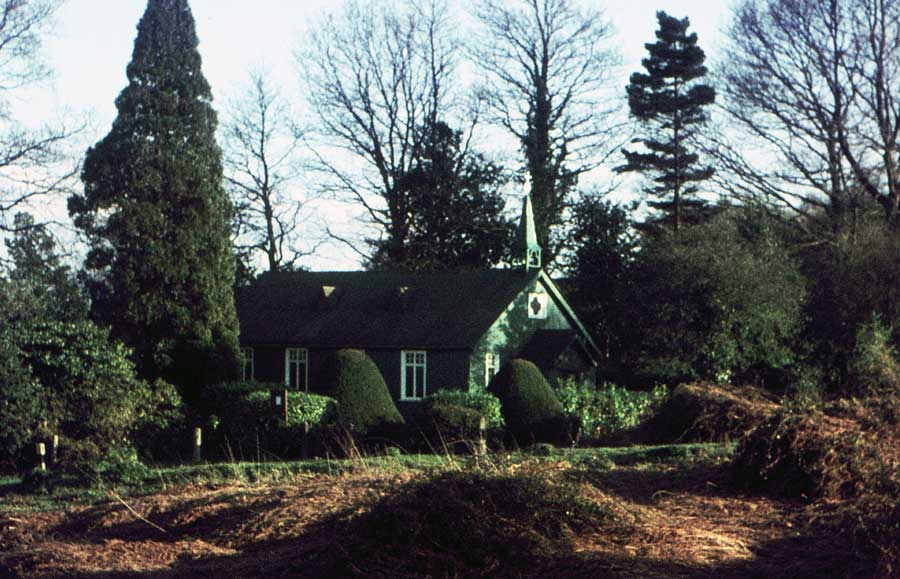 |
WHITB0URNE is a straggling parish, 5 miles east-by-north from Bromyard terminal station on a branch of the Great Western railway, 10 west from Worcester and 19 east from Hereford, on the road between Worcester and Leominster, on the Worcestershire border, and bounded on the north and east by the river Teme, the banks of which in many places are lofty and precipitous; it is in the Northern division of the county, Broxash hundred, Bromyard union, and county court district and petty sessional division, rural deanery of Frome, Northern division and archdeaconry and diocese of Hereford. The church of St. John the Baptist is an ancient building of stone, originally in the Norman style, consisting of chancel, nave of 4 bays, north aisle, south porch and an embattled western tower, with pinnacles, containing 6 bells: the church was restored in 1867, and in 1872 a new east window, in memory of the late rector and the late John Freeman esq. of Gaines, who died in 1870, was erected at a cost of £300, raised by subscription: the porch was erected by the parishioners at a cost of £100, from the designs of Mr. F. R Kempson, architect, to the memory of the Rev. George Bellett M.A. rector from 1870 to 1886: an organ was erected in the chancel by public subscription in 1891; at the entrance to the churchyard is a lych gate. The register dates from the year 1588. The living is a rectory, average tithe rent-charge,326, gross £381, and 34 acres of glebe, with residence, in the gift of the Bishop of Hereford, and held since 1886 by the Rev. Joseph Henry Brierley M.A. of Wadham College, Oxford, who is prebendery of Hereford Cathedral and rural dean of North Frome. There is an iron mission church in connection with the Church of England on Bringsty common, erected in 1891, at a cost of £180, at which service is held every Sunday afternoon. Here also is a small Primitive Methodist chapel. A parish reading-room was erected by the late E. B. Evans esq. at Meadow green. Gaines, 1 1/2 miles south from the church, is the residence of William A. Adams esq.; the house is situated in a park with ornamental grounds, approached on the north through an avenue of noble trees, and affords a fine view of the Malvern and Ankerdine hills. Whitbourne Court, the seat of His Honor Sir Richard Harington bart. J.P ., D.L. county court judge of No. 22 and 23 circuits was formerly the residence of the Bishops of Hereford, and adjoins the church. Whitbourne Hall, the seat of Mrs. Evans, is a modern mansion about 2 miles west of the church, with a stone colonnade on the south side and surrounded by ornamental grounds. Ferneybank is the seat of Mrs. Childe Freeman. The Ecclesiastical Commissioners are lords of the manor. His Honor Sir R. Harington bart. Mrs. Evans and Mrs. Childe-Freeman, John H. Lutley esq. of Brockhampton and Lieut.-Col. Henry Griffiths are chief landowners. The soil is clayey, upon gravel and sandstone. The chief crops are wheat, beans, apples and hops. Cider is made here. The area is 3,087 acres; rateable value, £5,231; population in 1891 was 672.
Parish Clerk & Assistant Overseer, William Ashcroft
Post & M. O. 0., S. B. & Annuity & Insurance Office.
Miss Ellen Garness, sub-postmistress.
Letters through Worcester arrive at 6.15 a.m.; dispatched at 6.40 p.m.
The nearest telegraph office is at Knightsford Bridge.
Wall Letter Box close to the church; hours of collection, 6.10 p.m.; sundays at 2.10 p.m. & one at Bringsty common, cleared at 6.30 week days & sunday
School (mixed), built in 1885, for 100 children; average attendance 90; William John Harwood, master; Mrs. Sarah Harwood, mistress
County Police, John Cross, constable
Carriers to Worcester. Mrs. Field, George Jones, & Charles Williams wed. & sat. Returning same day.
Adams William A., D.L., J.P. Gaines
Andrews Charles, Kennetts
Brierley Rev. Joseph Henry M.A. (rector, & prebendary of Hereford Cathedral & rural dean of North Frome)
Childe-Freeman Mrs. Ferney bank
Harington His Honor Sir Richard bart. D.L., J.P . (chairman of quarter ses-
Evans Mrs. Whitbourne hall
Woakes Mrs. Nutshell cottage
COMMERCIAL
Ashcroft William, shoemaker, parish clerk & assistant overseer31st March 1901 Census
Whitbourne, Herefordshire.Joseph Henry Brierley - Occupation: Clergyman Church of England.
Born: 1841 Rochdale.
Died: 24th August, 1911. 'Wyerville', Bridstow, Ross, Herefordshire.Ellen Brierley
Born: 1840 Leeds, Yorkshire.Married Ellen Teale
December qtr., 1868.
At: Leeds, Yorkshire.Catherine Brierley [daughter]
Born: 14th September, 1879 Rochdale, Lancashire.Wilfred Edward Brierley [son]
Born: 1881 Womersley, Yorkshire.
Hereford Times 14th December 2015
The corrugated iron church originally costing £70 served the community of Bringsty near Bromyard between 1891 and 1988, before it fell into disuse. It was rescued, rebuilt and rededicated at Worcestershire based Avoncroft Museum of Historic Buildings in 1996 before an extensive programme of repair and refurbishment work of the church took place, which is now near completion.
The outside of the building has been repainted and restored it to its original colour and the bell tower, which had fallen into disrepair, is back to full working order. Chris Everall, of Avoncroft Museum said: "The church is unusual in that it was delivered as a 'flat pack' and transported two and a half miles uphill from Brockhampton railway sidings to Bringsty Common.
"Churches such as these, with a wooden frame and corrugated iron cladding, were widely used throughout the British Empire towards the end of the 19th century and came in kit form to be assembled in places as far afield as the Caribbean, Australia and New Zealand.
"Local residents often called it the 'Iron Church' or 'Tin Tabernacle'. As a dedicated rather than consecrated church, Bringsty could host baptisms but could not be used for weddings or funerals.
"The church is now part of Stoke Prior parish and regularly hosts wedding blessings and seasonal celebrations such as harvest festivals and Christmas carol services."Avoncroft - Bringsty Mission Chapel.
This little chapel was built in 1891 for the cost of just £70. Made of corrugated iron with a wooden interior it was as much prefabricated as the post-war prefab house. That being that it was built in different sections in a factory and was assembled on its site. There were a lot of chapels like this, which could be ordered from catalogues to a variety of designs.
Originally the building was sited in Bringsty in Herefordshire as a place for worship for a 200 strong community who lived away from their local parish church. It thus served as a satellite of that church, able to perform baptisms but not weddings or funerals.
With congregations dwindling it closed in 1988 and was moved to the museum in the mid 1990s, complete with its furnishings and organ.
This church was built at the side of the Worcester to Bromyard Road in the parish of Whitbourne, Herefordshire in 1891. The church was purchased from the catalogue of J. C. Humphries, a London Iron Merchant and Manufacturer, at a cost of £70. It was supplied in prefabricated kit form; and early flat pack. Referred to locally as the 'Iron Church' or 'Tin Church', it served the Anglican worshippers of Bringsty Common, and could hold approximately 100 people.
The Reverend Brierley, who was the rector and founder of the Church, died in 1911. He was succeeded by Robert Harrington from 1913 to 1933. Later vicars where W. H. C. Stainer, the Rev. Grear, and the Rev. Robert Colby.
At the turn of the century, around 200 people lived on the common. The population was served by the "Live and Let Live' public house, whose landlord in the 1890's was Edmund Morgan.
Morgan's grandson, John Challen , who lived on the common for 88 years, was a long-serving member of the congregation of the church and his wife was the organist there until it closed.
Concerned that people were attending the local Methodist Chapel (est., 1861), the Church of England began to raise funds for a church on the common. Much of the money came from wealthy benefactors, including Mary Childe_Freeman, Frances Agnata Harrington and Cecilia Biscoe.
The church arrived in the form of a flat pack at nearby Brockhampton railway sidings and was then transported by horse and cart the two and a half miles up to its permanent site.
By 1984 the local population was half that of 1851, which together with a general decline in churchgoing, contributed to the eventual demise of the Bringsty church. It finally closed in 1988.
Following an approach from the Rector R. J. Colby in the late 1980's, Avoncroft Museum took the decision to save the church. The church had been well maintained and was generally in good condition. The interior of the church was complete; the font, lectern, pulpit, pews and vestments, which were in the Church at Bringsty, were rescued before dismantling began. The organ was removed 1994 and restored by Trevor Tipple, a Worcester organ builder. The church was dismantled in 1995 and moved to Avoncroft by a team from C & L Walker Ltd., of Kidderminster.
It was rededicated on 22nd May, 1966 in the presence of the Bishops of Hereford and Worcester. Amongst the guests were a number of former worshippers from Bringsty, including John Challen and his wife.

 ©peh
©peh 